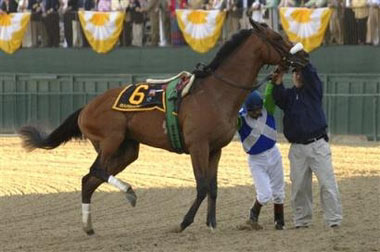Kentucky Derby winner Barbaro came out of a day-long surgery Sunday to repair
three broken bones in his right rear leg and "practically jogged back to the
stall," the colt's surgeon said.

Barbaro
is held by jockey Edgar Prado and a track worker after injuring his leg at
the start of the 131st running of the Preakness Stakes, Saturday, May 20,
2006, at Pimlico Race Course in Baltimore. [AP
Photo] |
At this moment "he is extremely comfortable in the leg," said Dr. Dean
Richardson, who stressed before the marathon procedure that he's never worked on
so many catastrophic injuries to one horse.
Barbaro sustained "life-threatening injuries" Saturday when he broke bones
above and below his right rear ankle at the start of the Preakness Stakes. His
surgery began around 1 pm Sunday at the University of Pennsylvania's New Bolton
Center for Large Animals.
At the front gate, well-wishers already had tacked up signs: "Thank you,
Barbaro," "Believe in Barbaro" and "We Love you Barbaro."
"You do not see this severe injury frequently because the fact is most horses
that suffer this typically are put down on the race track," Richardson said
before the surgery began. "This is rare."
Unbeaten and a serious contender for the Triple Crown, Barbaro broke down
Saturday only a few hundred yards into the 1 3-16-mile Preakness. The record
crowd of 118,402 watched in shock as Barbaro veered sideways, his right leg
flaring out grotesquely. Jockey Edgar Prado pulled the powerful colt to a halt,
jumped off and awaited medical assistance.
"It's about as bad as it could be," Richardson said of the injury. "The main
thing going for the horse is a report that his skin was not broken at the time
of injury. It's a testament to the care given to the team of doctors on the
track and (jockey) Mr. Prado on the racetrack."
Horses are often euthanized after serious leg injuries because circulation
problems and deadly disease can occur if they are unable to distribute weight on
all fours.
Barbaro was fitted for an inflatable cast by the attending veterinarian, Dr.
Nicholas Meittinis, and the colt trained so expertly by trainer Michael Matz was
taken to the Bolton Center.
There had been no sightings Sunday of Matz or owners Roy and Gretchen Jackson
at the facility, which was swarming with media awaiting an update. The Jacksons
reportedly were at the center for the start of surgery, but left.
"Two weeks ago we were on such a high and this is our worst nightmare," Matz
said Saturday night at the center. "Hopefully, everything will go well with the
operation and we'll be able to save him."
Richardson outlined Barbaro's medical problems: a broken cannon bone above
the ankle, a broken sesamoid bone behind the ankle and a broken long pastern
bone below the ankle. The fetlock joint - the ankle - was dislocated.
The breaks occurred as a result of an "athletic injury," said Corinne
Sweeney, a veterinarian and the hospital's executive director.
"It's an injury associated with the rigors of high performance," she said.
"They were designed as athletes and they are elite athletes, thus they incur
injuries associated with performance. The frame sometimes plays a role,
absolutely."
Barbara Dallap, a clinician at the center, was present when Barbaro arrived
at the center Saturday night.
"When we unloaded him, he was placed in intensive care and we stabilized him
overnight," Dallap said. "He was very brave and well behaved under the situation
and was comfortable overnight."
Tucked away on a sprawling, lush 650-acre campus in Chester County, the New
Bolton Center is widely considered the top hospital for horses in the
mid-Atlantic region. The center is renowned for its specialized care, especially
on animals needing complicated surgery on bone injuries.
The Jacksons live less than 10 miles away on their farm
in West Grove, outside Philadelphia in the horse country of Chester
County.